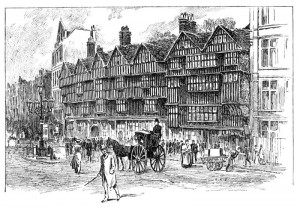By Lisa Smith, W&M Contributor
Helen King recently discussed the long history of depicting midwives as murderers. In the lively comments section, Michelle Moon wondered whether midwives were frequently prosecuted for infanticide. In short, the answer is no. But that didn’t mean there weren’t stories! One such murderous midwife, Mrs Adkins, played a starring role in a ghost story, Great News from Middle-Row in Holbourn (1680).

Staple Inn, Holborn, 1900. Middle Row would have stood next to it until the late nineteenth century. Source: Walter Besant, The Fascination of London Holborn and Bloomsbury (Wikimedia Commons and Project Gutenberg).
The pamphlet (Great News) reported that Mrs Adkins’ restless spirit returned about six months after her death. Middle Row no longer exists, but the row of cramped houses was then to be found blocking up the south end of Gray’s Inn Road. Former neighbours in the Row complained of being frightened by “strange Apparations resembling her shape and form”. There were noises, visions, and “Impetuous Groans”, but these “dismal Echoes of some strange Event” were largely ignored.
Then, on Tuesday the sixteenth of March 1679 at nine in the evening, the spirit took on mortal shape, as it “would no longer keep concealed what was the cause of its disturbance”. The servant of the house had been sent upstairs on an errand and was, as you might imagine, surprised to discover next to the cupboard an apparition. The figure that appeared to be Mrs Adkins, who “with ghastly Countenance seemed to belch flames of Fire”. The poor servant was terrified, but the spectre instructed her to be not afraid and asked her to pass on a message to Mary (possibly Mrs Adkins’ grand-daughter): “take up two Tiles in the hearth, and under them should find a board and what she found beneath, that she should bury”. The ghost then “in a Flash of Lightning Vanished”.
Once the maid had recovered her wits, she recounted her experience to her employers. Initially, the master and mistress disbelieved her, but the maid’s continued insisted and the prior reputation of a haunting combined to persuade them to investigate. They found concealed beneath the tiles the bones of two children. Surgeons concluded that the bones had been there for many years, thus clearing the current occupants of any suspicion and suggesting that Mrs Adkins really was guilty. Popular conjecture was that the bodies belonged to “Children Illegitimate, or Bastards who to save their Mothers’ Credits had been Murdered, and buried there”.
In life, Mrs Adkins had been a discreet midwife (“extraordinary subtlety and private policy”), but a somewhat odd character tending towards boastfulness and saying peculiar things. Now it all seemed to make sense, with her discretion taking on a sinister aspect. But “no secret”, declaimed the pamphlet, “can overpass his [God’s] boundless wisdom, nor escape his sight; nay Hell itself has not a depth sufficient to obscund prodigious crimes from him”. Even in death, the midwife’s soul bore the “lasting stain” of murder, and she was compelled to reveal her crime.
A short, but complex, tale: ghost stories are always laden with cultural meanings. Peter Marshall sees this as an example of a religious tale in which God’s power was always triumphant, no longer (as Great News puts it) letting a “Monstrous Crime” remain “masked in Darkness”. Laura Gowing considers the pamphlet within the context of growing fears about infanticide and illegitimacy; Mrs Adkins was depicted as the baddie who aided and abetted women in keeping their nefarious secrets. We might even read the story in terms of Mrs Adkins’ difficult personality. Her oddness in life might have predisposed people to expect her to haunt them in death, a motif that Paul Barber has noted in early modern vampire accounts…
What do you think?
Lisa Smith is an Associate Professor of History at the University of Saskatchewan. She writes on gender, family, and health care in England and France (ca. 1600-1800) and recently taught a course on natural and supernatural worlds in early modern Europe.
Further Reading
Barber, P. Vampires, Burial and Death: Folklore and Reality (Yale University Press, 1990).
Gowing, L. Common Bodies: Women, Touch and Power in Seventeenth-Century England (Yale University Press, 2003).
Marshall, P. Mother Leakey & The Bishop: A Ghost Story (Oxford University Press, 2007).
